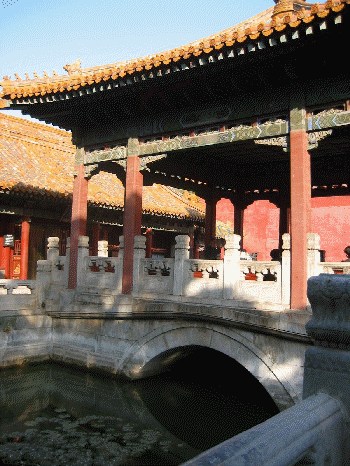
The Imperial Garden is at the back of Houqin. Though it is called a garden, all the structures, roads, ponds and even flower beds and plants are regular and symmetrical, with only some local changes, differing, vastly from the free pattern which is especially emphasized inChinese gardens. This is because it is a garden inside the strictly patterned and symmetrical imperial palace and is located in the axis, so that the local must be subordinated to the whole in order to maintain the complete style of the latter However, ancient trees there tower to the skies with branches and leaves shading the ground, so that, after all, it is a place full of the delights of life.
Getting through a small square to the north of Yuhuayuan (Imperial Garden), one finds Shenwumen where there is a high tower. Passing the gate through the city moat leads one to jingshan, the end of Forbidden City. Jingshan is high in the middle and low on both sides, in line with the encircling hill, on the ridge of which are five pavilions.
As a forceful end of the magnificence derived from the axial line of the Forbidden City, obviously the size of Jingshan cannot be too small. The structure, however, cannot be too big, so as to avoid taking anything away from the momentum of the structures inside the palace. Artists designed a very big jingshan here and built smaller pavilions on the top of the hill to skillfully solve the problem. Jingshan is the backdrop of the entire palatial city, thus enriching the horizontal line visible there.
Wanchun Pavilion in the middle of jingshan is the largest. It is a square three-layered eaved structure, with yellow as the main color; the two pavilions on both sides are smaller, octagonal multi-eaved structures chequered with yellow and green. The two outermost pavilions are the smallest, round, multi-eaved structures, with green as the main color. Rich, rhythmic change is given to the volume, form and color, and atmospheric harmony is gained respectively with the solemn palace and the lively imperial garden outside.
The Forbidden city is the best model in the design of a complex of buildings in ancient Chinese architectural art. When expounding on the perfection of artistic works in his Study of Poetry the ancient Greek esthetic Aristoteles said: By perfection here I mean a thing with a beginning, middle and, .d. The beginning does not need any hypothetical thing before it, but there should be something following it. The end, on the contrary, must have certain assumed things before it, either necessity or probability, but it does not need anything to follow. The middle assumes certain things have taken place before it and something will follow it. According to him, any artistic work must use the principle of the unity of multification, and each group of components must have characteristics con forming with their own identity, while the entirety should constitute an organic entity. The design of various parts in the axial line of Beijing's palaces all conform with this principle. But it is far more complicated than the situation summed up by Aristoteles, demanding that artists develop a more careful observation capability and greater vigor to control the whole situation.
The Forbidden City enjoys a high reputation in the world. Referring to it in his famous work, The Science and Civilization of China, Joseph Needham, a well-known British scholar, said: We discover a series of separate spaces which are linked to each other...they are contrary to palaces during the Renaissance age, for example, in the Palaces during the Renaissance age, for example, in the Versailles, where the visual point is completely concentrated in a single structure, and the palace is separate from the city. In contrast, China's concept is very profound and complicated, because in a composition of the picture there are hundreds of structures, and a palace itself is only apart of a greater organic body of the entire city together with its city walls and streets. The Chinese concept is also extremely delicate and changeable involving blended interests. He said the whole form of China's great architecture has become an organic pattern that no culture can Surpass.
(Source: chinaculture.org)

Copyright ©1999-2011 Chinanews.com. All rights reserved.
Reproduction in whole or in part without permission is prohibited.